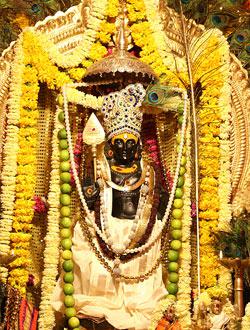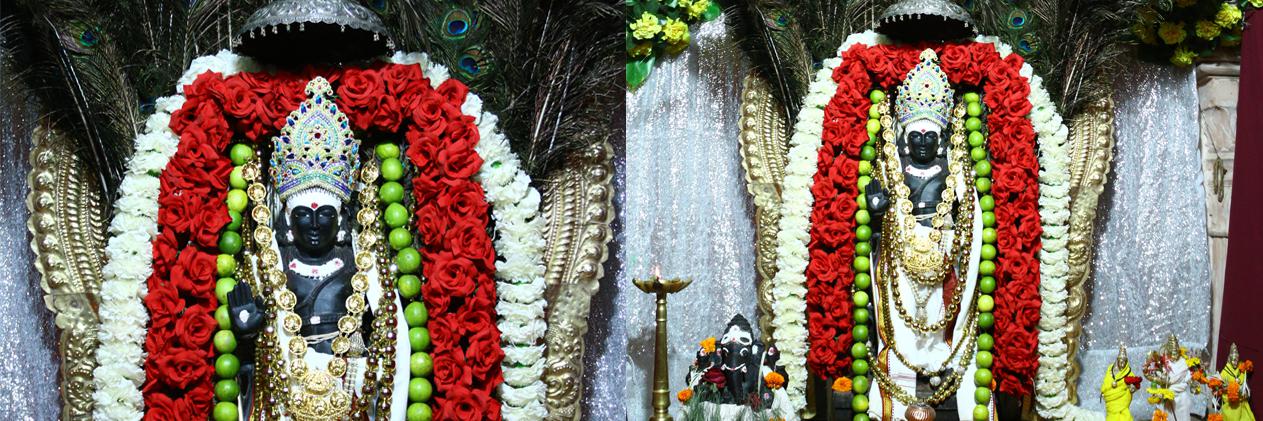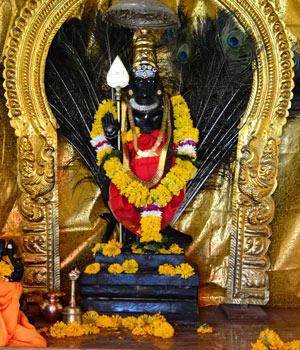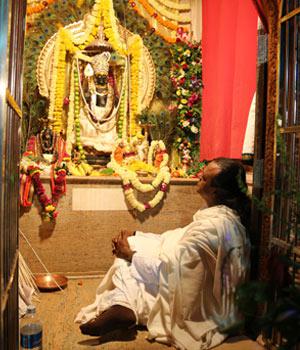When Panchami Tithi ends or Shasti Tithi starts between sunrise and sunset then both Panchami and Shasti are conjugated and this day is chosen for Skanda Shasti Vratam. This rule has been mentioned in Dharmasindhu and Nirnayasindhu. Many Murugan temples in Tamil Nadu, including famous Sri Subrahmanya Swami Devasthanam in Tiruchendur, follow the same rule and Soorasamharam day is observed one day before Shasti Tithi if on previous day Shasti Tithi is combined with Panchami Tithi.
Although all Shasti(s) are dedicated to Lord Murugan but Shukla Paksha Shasti during lunar month Kartika (which is during Solar month Aippasi or Karthikai) is the most significant one. Devotees observe six days fast which lasts on Soorasamharam day. Next day after Soorasamharam is known as Tiru Kalyanam.
Next Skanda Shasti after Soorasamharam is known as Subramanya Shasti which is also known as Kukke Subramanya Shasti and falls during lunar month Margashirsha.
Skanda Shasti is observed on the sixth day of the bright fortnight of the Tamil month of Aippasi (October – November). This day is dedicated to the second son of Lord Shiva – Lord Subramanya, also known as Kartikeya, Kumaresa, Guha, Murugan, Shanmukha and Velayudhan, who on this day, is believed to have annihilated the mythical demon Taraka. Celebrated in all Shaivite and Subramanya temples in South India, Skanda Shasti commemorates the destruction of evil by the Supreme Being.
-
How to Celebrate Skanda Shasthi :
On this day, elaborate festivals are held with grandeur in South India. In many places the festival commences six days before the Shasti day and concludes on the day of the Shasti. During these days, devotees recite inspiring hymns, read stories of Subramanya, and enact the exploits of the Lord on stage. Thousands of people gather for feasts, and massive amounts of camphor are burnt.
-
Penance and Piercing :
It is customary to undergo penance on Skanda Shasti in the form of carrying a ‘Kavadi’ to the various Subramanya shrines. Many devotees also pierce long needles through their cheeks, lips and tongue as they go into a delirium charmed by the powers of the Lord.
-
Hymns & Prayer for Lord Subramanya :
The Tiruppugal, a popular religious book in Tamil, contains the inspiring devotional songs of Arunagirinathar in praise of Lord Subramanya. Hymns from Kavadichindu and the Skanda Shasti Kavacham are also sung on this occasion. Here is a prayer in English for the occasion by Swami Sivananda:
'O my Lord Subramanya, O all–merciful Lord, I have neither faith nor devotion. I do not know how to worship Thee in the proper manner, or to meditate on Thee. I am Thy child who has lost his way, forgotten the goal and Thy Name. Is it not Thy duty, O compassionate Father, to take me back?
'O Mother Valli, will you not introduce me to Thy Lord? They love for Thy children is deeper and truer than that of anyone else in this world. Though I have become Thy worthless and undutiful child, O beloved Mother Valli, pardon me! Make me dutiful and faithful. I am Thine from this very second; always Thine. All is Thine. It is the Mother's duty to correct her reckless child when it strays aimlessly on the wrong path. Remove the veil of delusion that separates me from Thee. Bless me. Enlighten me. Take me back to Thy holy feet. This is my fervent prayer to Thee and Thy Lord, my beloved and ancient Parents.'
-
How to observe shasti vratham at home :
Shasti Vratam or Upvaas is an important fast dedicated to Lord Muruga or Kartikeya. There are two Shast is in a Hindu lunar month. One Shasthi after no–moon or new moon day (amavasya) and another after Purnima (Pournami). The Shasti coming after Amavasya (new moon night) is the one meant for fasting. In simple terms, the Shasti coming during the increasing or growing phase of the moon. Lord Muruga is also known as Subramanian or Skanda or Kanda.
-
How to observe Shasti Vratam? :
1. The Shasti fasting begins with sunrise. The fast is broken on the next day morning after praying to Lord Surya (Sun God).
2. Most people observing the fast make it a point to visit Murugan Temple on this day.
3. It is a complete fast in many places. But this might not be quite possible for many people due to job, health and other reasons. So many people take some sort of vegetarian food on this day – this is usually a single meal in the afternoon or night.
4. Many people opt for a fruit diet on the day. Some avoid solid food.
5. In several Kerala Muruga temples, many devotees eat a single rice meal at noon given from the temple. The cooked rice is consumed without any major side dishes.
6. The method of fasting differs from region to region. But all non–vegetarian food is avoided on the day.
7. Devotees listen to stories related to Skanda and reading of Skanda Purana. Another activity during the day is the reciting of Kanta Shasti Kavasam.
8. Fasting is not just abstaining from food but it also an attempt to instill positive thoughts. Many people use fasting as a means to fight against anger, lust, impatience and other negative tendencies. All Vratas associated with Hindu religion is an attempt to realize the Brahman.
-
How to observe Skanda Shasti Viratham or fasting :
Skanda Shasti or Kanda Shasthi Vratam is an important observance dedicated to Lord Muruga. It is observed in the Tamil month of Aippasi and most devotees fast during the 6–day period.
There is no common method of Skanda Shasti fasting. Different devotees observe it differently. But there are some basic rules followed by all the devotees.
Non–vegetarian food is completely avoided during the period.
1. Some people also avoid garlic and onions.
2. Those who are observing the fast make it a point to read scriptures related to Lord Muruga or recite the Kanta Shasti Kavasam or Subramaniya Bhujangam.
3. Most devotees also visit Skanda temples during the period. When it comes to Kanda Shasti fasting, some devotees only take a single meal a day.
4. Some take the meal at noon and others at night.
5. Some devotees confine to fruits and juices during the 6–day period.
There are several Skanda devotees who see the Vratam as an opportunity to clean the body and get rid of unwanted toxic elements. Such devotees confine to water, coconut water and other fruit juices.
The fasting ends on the Sixth day.
It must be noted that ‘Vrat’ or ‘Vratam’ in Sanskrit means ‘vow.’ Vratam should not be misunderstood as mere fasting. By observing a Vratam a person is trying to purify his mind through meditation, worship and by sticking to some ‘vow’ that he/she has taken. Now, this vow can include fasting, not telling lies, not getting anger etc. A vratam should be seen as a deliberate attempt on your part to bring back discipline into your life.
Fasting should be voluntary and it should not be done unwillingly. If you are taking medicines, do not observe intense fasting and stick to the routine suggested by your doctor.






